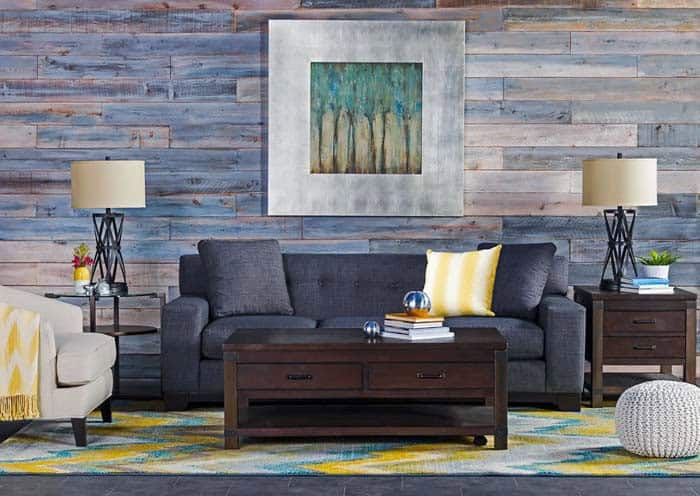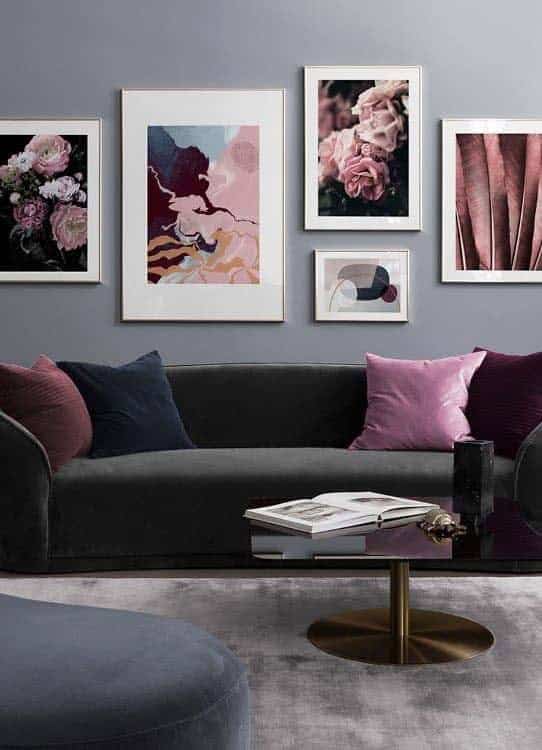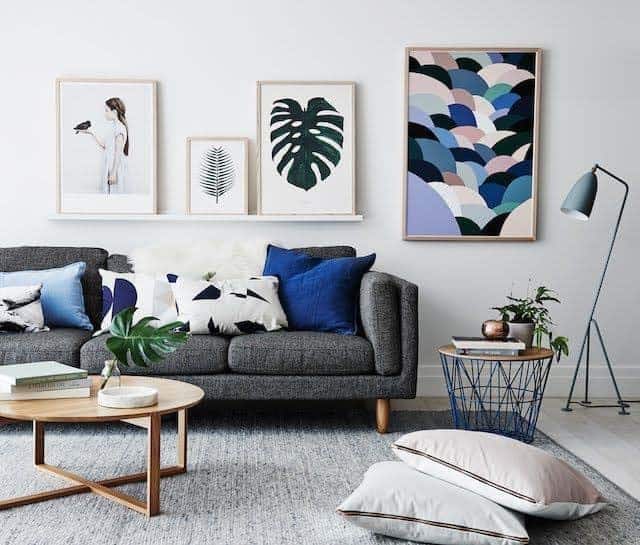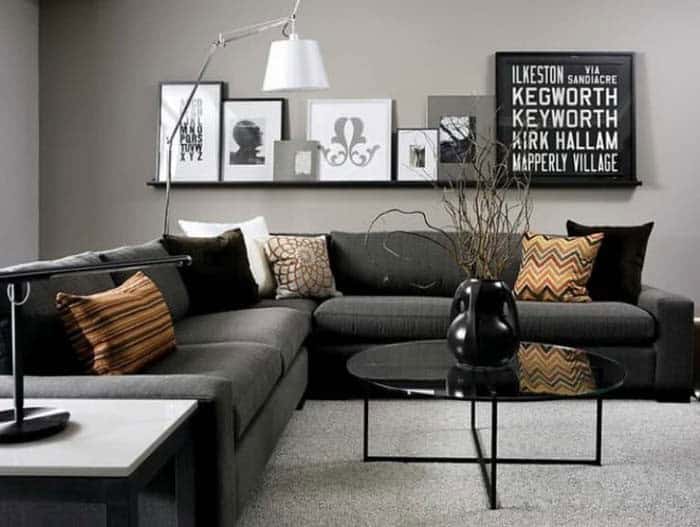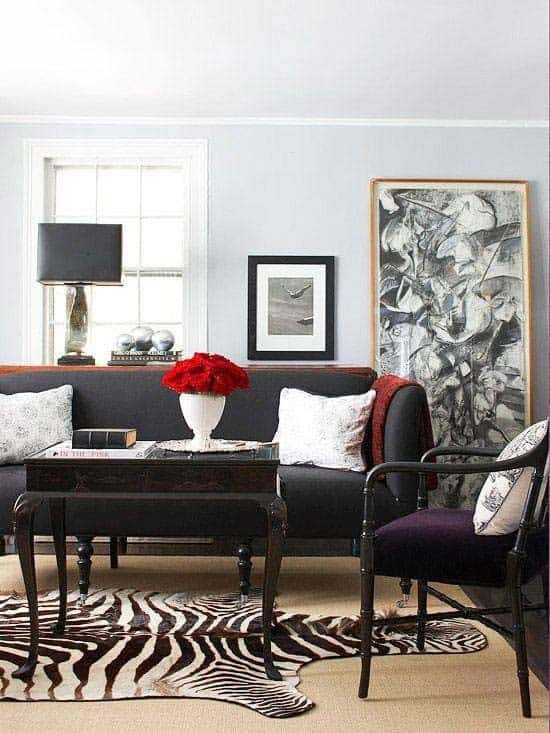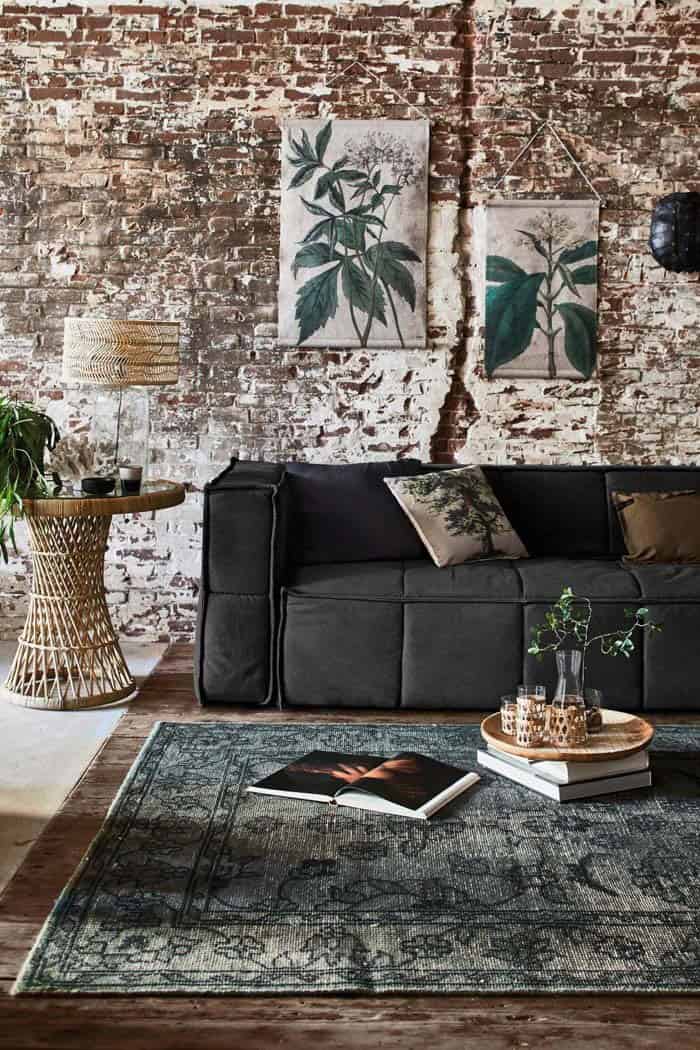The versatility of charcoal gray couches is one of their most appealing aspects. Whether you’re working with a small or large space, they seamlessly blend in and add depth without overpowering the room. When it comes to choosing the perfect colors to complement your charcoal grey sofa, it’s not just about finding harmonious shades that match its tone. It requires an understanding of how different elements interact to create a cohesive look.
To get started, let’s explore what defines charcoal gray. Essentially, it’s black with white undertones added to it. This unique combination gives rise to a cool-toned color that can be warm or calm depending on the context. For instance, Ashley Furniture offers a range of products that showcase the subtle nuances of charcoal gray. So, what colors work well with dark grey furniture? The answer depends on the mood you want to create.
If you’re aiming for a peaceful atmosphere, muted tones are a great choice. However, if you want to inject some energy into the space, brighter hues can help achieve that. When selecting wall colors to pair with your charcoal gray couch, consider the overall aesthetic of the room rather than just focusing on the sofa. Light-colored walls can create a striking contrast and make the couch stand out, while dark walls will allow it to blend seamlessly into the background.
Don’t forget to factor in the fabric type of your charcoal gray couch – microfiber and black leather, for example, will react differently to light. Ultimately, the key to choosing colors that complement your charcoal grey sofa is striking a balance between harmony and contrast.
Brown and Charcoal Grey
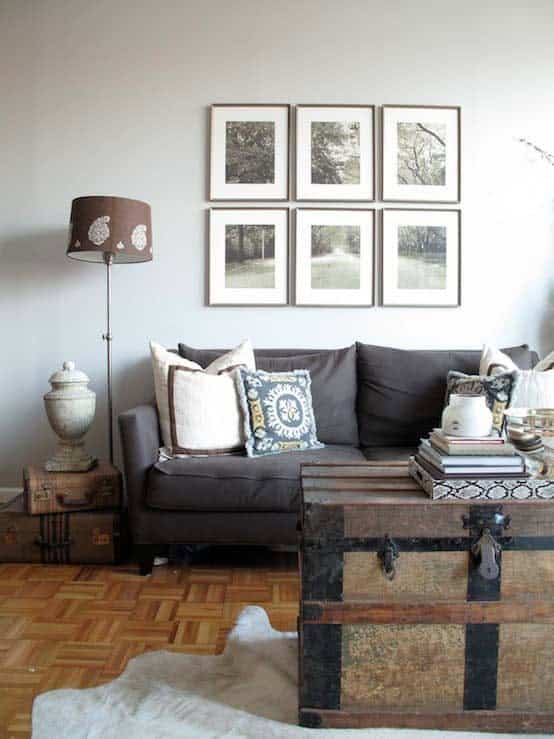
Blending earthy tones, brown seamlessly integrates with wood elements, creating a warm and inviting atmosphere. This combination takes center stage when paired with a gray couch, evoking a sense of rugged elegance. The harmonious union of these neutral hues produces a cozy, rustic ambiance that’s perfect for any living space.
Lime Green and Charcoal Grey
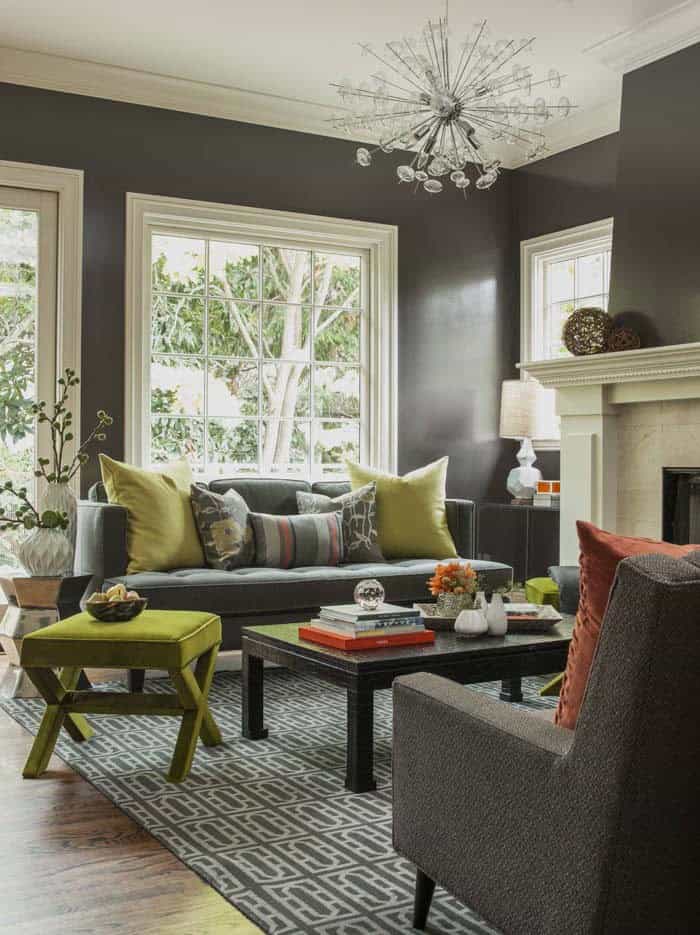
The eye-catching combination of deep green and yellow undertones on the charcoal gray sofa demands attention. Unlike the harmonious partnership seen with brown against light-colored walls, here, the couch serves as a neutral backdrop for the vibrant citrus accents that add a pop of color.
Orange and Charcoal Grey
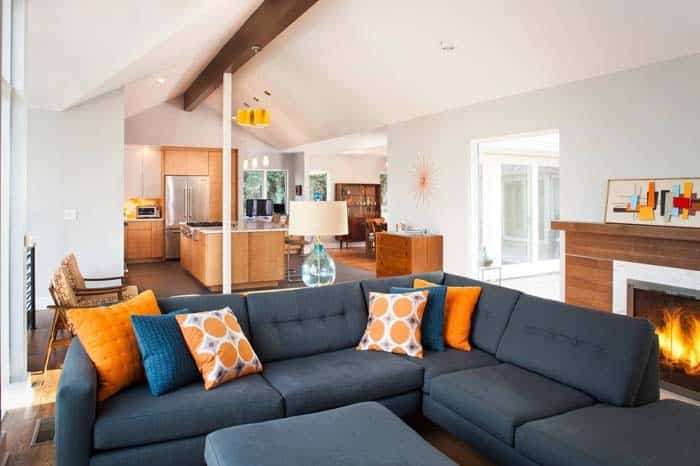
When incorporating citrus accents into your design, consider pairing vibrant oranges with neutral-toned furniture pieces. For instance, a warm orange hue can beautifully complement a dark gray couch featuring blue undertones. If you prefer a more subdued approach, opt for a muted orange shade that adds a touch of brightness without overpowering the space. In this example, a bold orange throw pillow can effectively bridge the room’s visual divide between light kitchen cabinets and an island.
Blues and Pinks
In this dark grey couch, the blue undertones are strikingly prominent. The unexpected injection of yellow, typically absent from the soft blues and pinks that dominate the living room’s palette, imbues the space with an energizing presence. This deliberate introduction of a vibrant color effectively complements charcoal gray hues that boast subtle blue or pink undertones, creating a harmonious balance.
All Natural Neutral

Adding depth to a room can be achieved through strategic use of dark colors. A vast, monochromatic space with no visual anchors can feel desolate and lacking in character. To create a sense of coziness and visual interest, incorporating rich hues is an effective approach. A plush, dark gray sofa serves as an ideal focal point for the eye to settle upon. Furthermore, it’s crucial to deliberate on the color palette of each piece of living room furniture to achieve harmony and balance.
The charcoal gray accent chairs, for instance, provide a delightful contrast to the surrounding space.
Burnt Orange
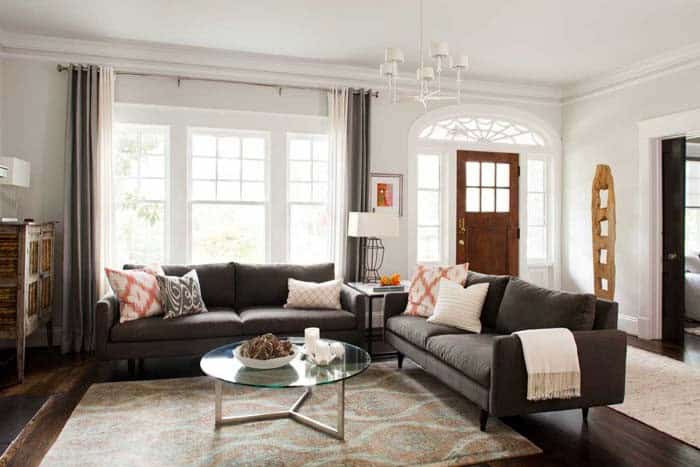
The impact of color on a space is remarkable, as evidenced by this example where even a small amount of orange adds vibrant energy to the room. The subtle connection between the orange accents and the warm hues in the brown door and area rug creates a sense of cohesion. Meanwhile, light gray walls effectively diffuse the natural light, preventing shadows from forming and maintaining a bright atmosphere.
This harmonious combination showcases how well-brown furniture can be paired with various wall colors.
Gold
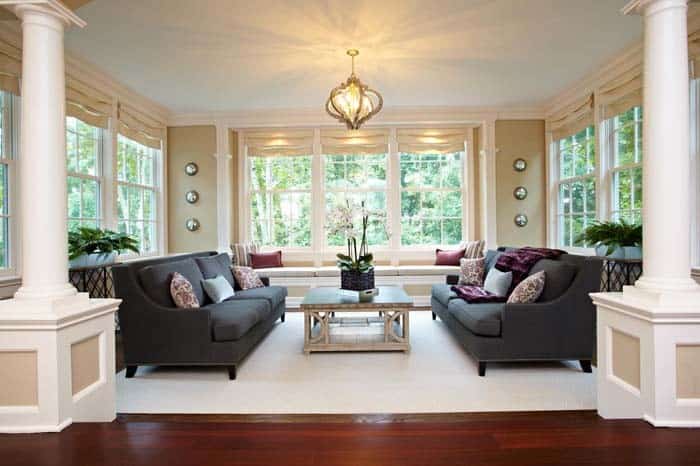
Combining charcoal gray and gold creates a sophisticated and elegant aesthetic. The charcoal gray, reminiscent of the timeless little black dress, provides a sleek backdrop for the warm, classic tone of the gold. This dynamic duo yields a high-end look that exudes refinement and style. A closer examination of the throw pillows and blanket reveals the undertone of the gray furniture is subtly violet, adding an air of sophistication to the overall design.
Wood and Charcoal Grey
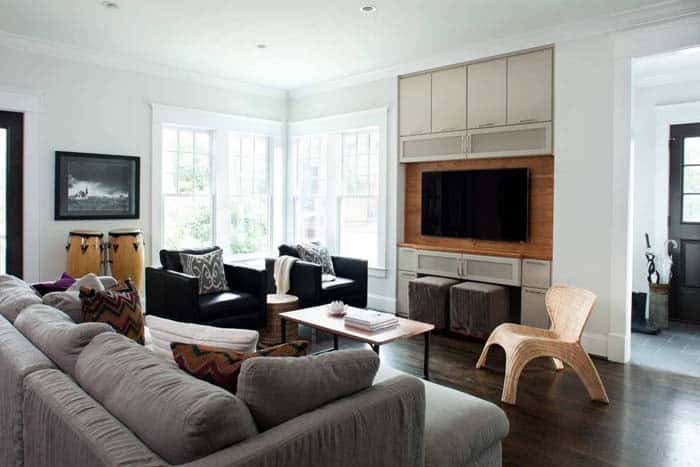
When discussing colors, we often overlook the unique characteristics of wood. While it may not be a traditional hue, wood deserves consideration beyond its brown undertones. The texture and vibrancy it introduces can elevate a space in ways that standard colors cannot. Stained wood with yellow undertones, for instance, can playfully interact with light, while ebony’s reflective quality adds an extra layer of depth.
The key is to treat wood as you would any other color palette – acknowledging its undertones and texture. This approach allows you to incorporate a charcoal gray couch alongside wood accents without concern, just as a blue-green undertoned couch can thrive in the same space.
Pink
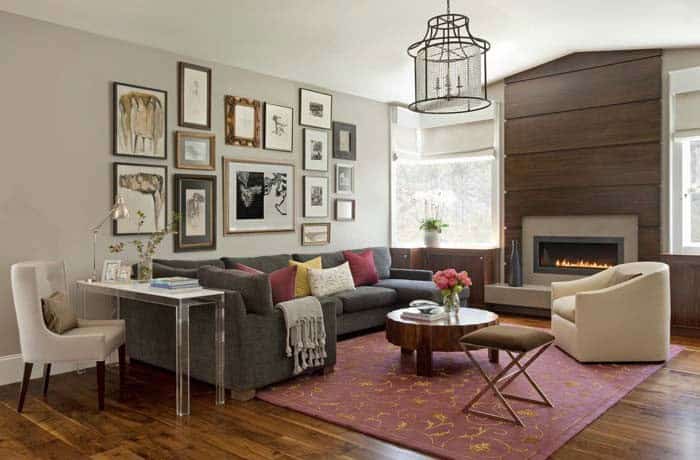
While pink is often associated with femininity, it’s not necessarily limited to a sugary sweet aesthetic. The warm undertones of the red hue can actually complement and enhance other design elements in the space, such as the rich tones of the hardwood floor and the fireplace overmantel. This is evident in the example provided by Peruri Design Company, where pink seamlessly transitions into charcoal gray with pink undertones, creating a cohesive and inviting atmosphere.
Dusty Rose, Navy, and Charcoal Grey
The versatility of this colour combination is truly impressive, spanning the entire visual spectrum. A dark grey sofa can seamlessly integrate with both blue-toned and pink-tinged shades, creating a harmonious balance. Meanwhile, dusty rose assumes an accent role in the wall decor and a throw pillow, adding a touch of elegance to the overall aesthetic.
Peacock Blue
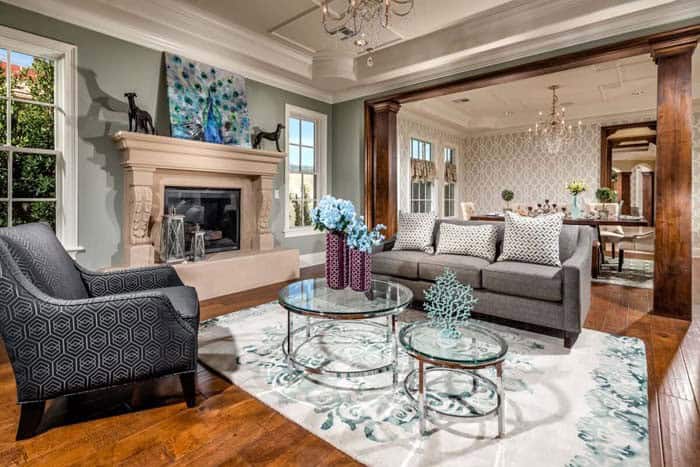
When it comes to pairing colours with a charcoal grey couch, you can add some vibrant pops of colour to create a stunning visual effect. For instance, a couch with blue-green undertones pairs beautifully with bright blues like peacock and turquoise. The key is to find the right balance between the neutral tone of the couch and the boldness of the brighter colours.
This is where transitional colours come in – they help bridge the gap between different design elements, such as the green that seamlessly connects your charcoal grey couch to the yellow hardwood floors and trim.
Teal and Charcoal Gray
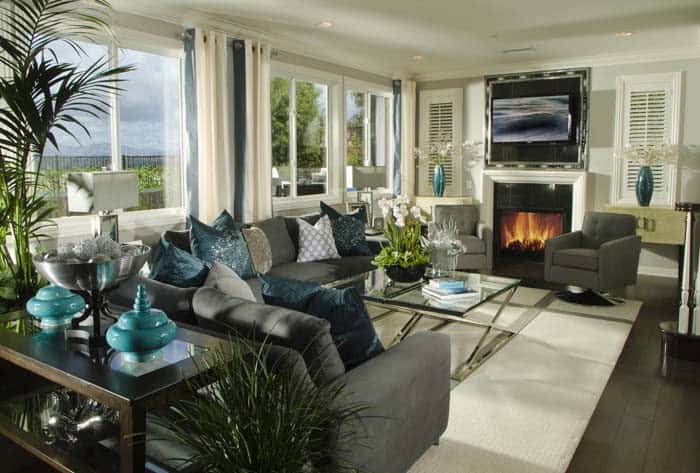
When it comes to pairing charcoal gray couches with colors, teal works similarly to peacock blue. The natural undertones of the gray bring a sense of calm and serenity to the space, making it an ideal complement to botanicals and other green hues in the room. By incorporating these elements, you can effortlessly create a coastal-inspired atmosphere that’s both soothing and stylish.
Blue and Green
Pairing charcoal gray with blue can create a timeless and versatile aesthetic. A classic combination, it’s hard to go wrong with a neutral base like charcoal gray. When it comes to choosing a blue hue, you have the freedom to select any shade that complements your sofa, regardless of its undertones. The beauty of this color scheme lies in its ability to accommodate different shades of green and even pops of pink.
The key to achieving harmony is keeping the wall color light with blue undertones, which allows the blue accent pieces to take center stage.
Shades of Gray Monochrome
In this understated living room, subtle pops of brown in the throw pillows are the only respite from an otherwise monochromatic palette dominated by various shades of grey. The charcoal-hued walls and carpet create a cohesive backdrop for a space that embodies a masculine, modern aesthetic, where every element from furniture to flooring shares a uniform gray tone.
Red, Black and White
Bold graphic statements can be made through striking black and white designs. The focal point of this space is undoubtedly the large area rug and impressive art piece, which are intentionally highlighted by the understated gray sofa. In fact, the choice of sofa color serves to complement the art without drawing attention away from it. Meanwhile, vibrant red accents add a pop of contrast, while the purple accent chair subtly connects with the sofa’s violet undertones.
Vintage Neutrals
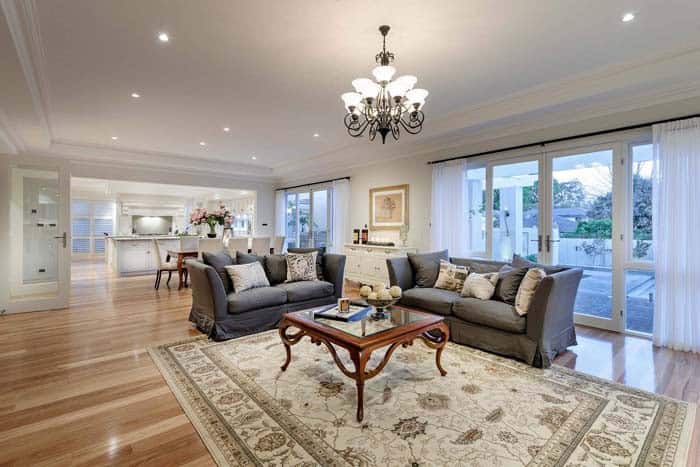
To create a harmonious ambiance, a vintage-inspired furniture arrangement requires balance. In this case, painting the walls a warm off-white hue and placing a beige rug in the room will provide a suitable backdrop for the furnishings. A touch of elegance is added with sheer curtains as the only true white elements in the living space. The gray couch may be modern in design, but its skirt gives it an aged appearance that blends seamlessly with the surrounding decor.
Botanical Green and Earthbound Brown
Integrating gray into a brown and beige color scheme can be a challenging task. However, by incorporating a dark charcoal gray couch, you can create a harmonious atmosphere that complements the antique rug and other rustic elements. The key to achieving this balance is the simplicity of the botanical motif, which adds an organic touch and shifts the space from industrial to rustic.
White Walls and Beige Floors
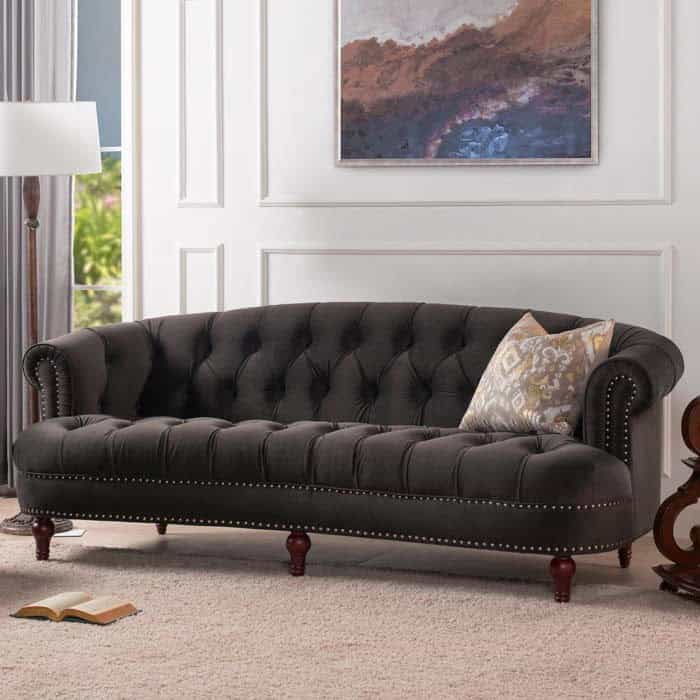
When designing an apartment complex, one common challenge is harmonizing a white wall with a beige carpet. To achieve this, choose a gray sofa that complements the undertones of the carpet. For instance, if the carpet has pink undertones, select a gray sofa with subtle pink hues. Conversely, if the carpet has blue undertones, opt for a gray sofa with blue undertones.
Adding golden accents through accessories like picture frames, throw pillows, and sofas can further enhance the transition between the white wall and beige carpet.
Bright Yellow
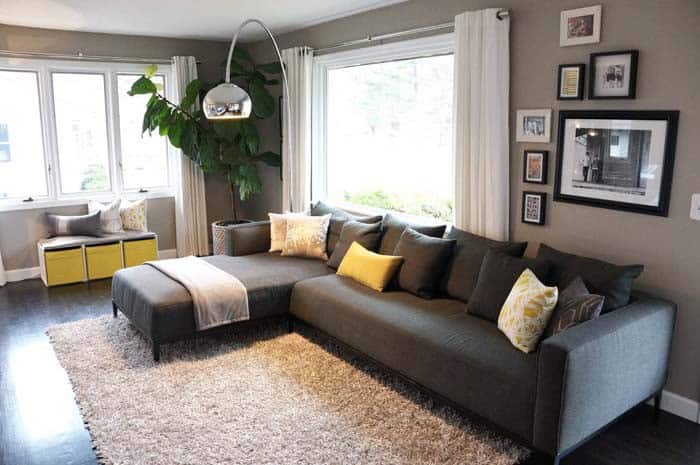
While bold color combinations can undoubtedly add depth and visual interest to a room, it’s often more effective to anchor the space with a single, statement-making paint color. This allows you to create a sense of cohesion while still incorporating pops of contrast through accessories or furniture pieces. For example, pairing a dark wall color with a dark grey sofa can be elevated by introducing unexpected bursts of yellow via throw pillows, vases, or other decorative elements.
By striking the right balance between harmony and contrast, you can achieve a look that is at once cohesive and visually stimulating.
Patterns, Yellow, and Charcoal Grey
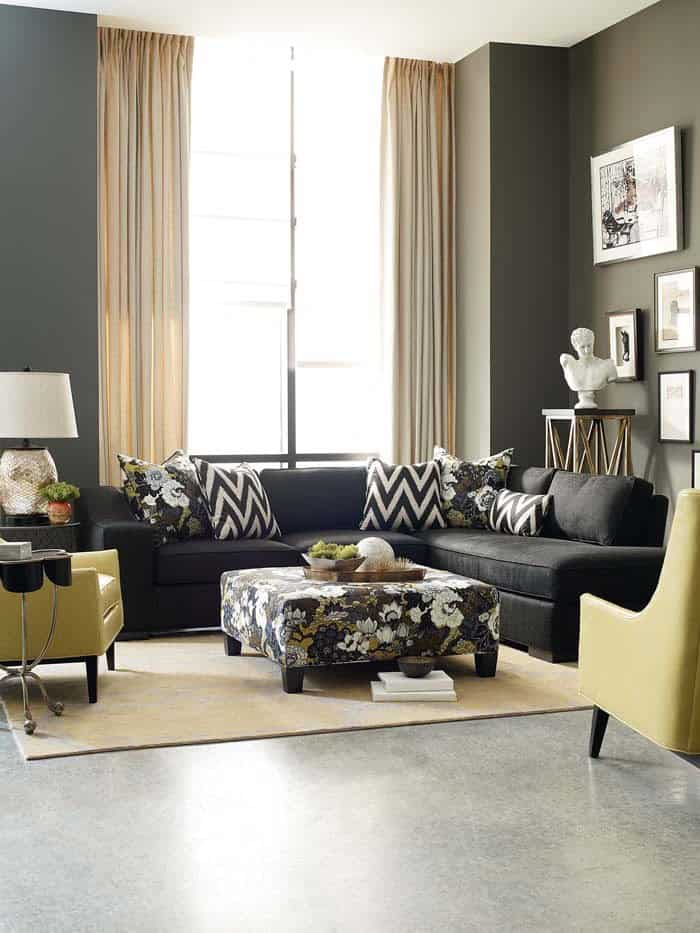
By incorporating a pattern on the coffee table, the entire color scheme of the living room is brought together seamlessly. This approach ensures visual harmony and creates a cohesive atmosphere. Similarly, when selecting curtains, it’s essential to consider them as another neutral element that complements the other colors in the space.
The chosen curtain color should be able to work in harmony with the existing palette, much like how different components of a well-designed room come together to create a harmonious whole.
